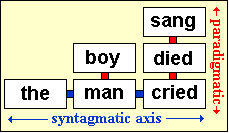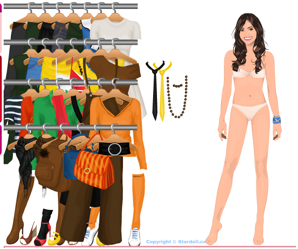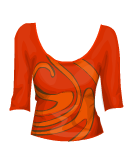Paradigm and Syntagm
Signs have two dimensions, the paradigmatic and the syntagmatic. These two treat signs as part of a system, and their determines the “value of a sign”.
By definition, paradigmatic tells us that it is a set of signs, those of which that have a common function. It can be seen as a contrastive factor because the signifiers in the same paradigm set shapes each other’s preferred meaning by virtue of mental associations. For example, a set of verbs, nouns, etc.
On the other hand, the syntagmatic is known to be the “chain” of signifiers, refers to the combination of signifiers taken from a paradigm to form a meaningful order. It is commonly found in drawing, painting and photography, drama, cinema, television and the world wide web. A few of examples of which are sentences (which make up paragraphs), paragraph (which make up chapters), chapter, print advertisment.
The illustration below shows the presentation of the 2 dimensions as "axes", with the paradigmatic as the vertical axis and the syntagmatic is the horizontal one.

An easier way to understand the paradigm and syntagm is to use a simple and relevant example. The movie, “Chasing Liberty”, starts out with Mandy Moore raiding through her closet, trying to figure out what to wear for a date. She tries on one outfit after another by mixing and matching the tops and undergarments. We can apply the Paradigm and Syntagm in this situation by substituting each piece of clothing as the “signifiers” in the paradigm, while utilizing the act of “mix and match” as a representation of paradigm. The paradigmatic elements are the items, which cannot be worn at the same time on the same part of the body (such as hats, trousers, shoes). The syntagmatic dimension is the juxtaposition of different elements at the same time in a complete ensemble from hat to shoes.

1.
Mandy selects signs from three paradigms (i.e. sets of possible signs - upper body garments, lower body garments, and footwear). Each paradigm contains a possible set of pieces from which she can choose only one. From the upper-body-garment paradigm (including blouses, tee-shirts, tunics, sweaters), she selects one.

These items share a similar structure, function, and/or other attribute with others in the set: they are related to one another on the basis of similarity.
2.
She further selects items related by similarity from the lower-body-garment and footwear paradigms. A socially defined, shared classification system or code shapes her selections.

3. Ana, as played by Mandy Moore, combines the selected signs through rules (i.e., mini-skirts go with stilettos for a date, not sneakers), sending a message through the ensemble - the syntagm.


4. Selection requires her to perceive similarity and opposition among signs within the set (the paradigm), classifying them as items having the same function or structure, only one of which she needs. She can substitute, or select, a blouse for the tee-shirt - conveying a different message. The combination, long sleeves–mini-skirt–stilettos, requires her to know the 'rules by which garments are acceptably combined. The combination is, in short, a kind of sentence. The long sleeves-mini-skirt-stilettos syntagm conveys a different meaning (sends a different message) at the beach than at a formal occasion.

Source: http://www.aber.ac.uk/media/Documents/S4B/sem03.html
http://www.stardoll.com/en/dolls
10 comments:
this is very interesting! :)
haha.you learn something everyday.
i can apply your next entry to this one. the myth in the part about mandy is that girls should be skinny and wear nice clothes or rich people (wasn't she the daughter of the president?) should have good fashion sense.
was that right?
-Z.
very clear example to discuss an otherwise rather confusing topic!! great job and keep it up! :)
You're a genius!! Finally understood the concepts after weeks on end of researching the internet for a clear example
Really great
Perfectly simplified! Thanks!
Thank you for making it easier to understand :-)
Excellent explanation thank you. :)
There seems to be comment likely no one visit this sight. The last was 2018 "excellent explanation thank you. The integrated embodied linguist structure creates emotional bondage to the reflected linguist paradigm.Thank You.
There seems to be comment likely no one visit this sight. The last was 2018 "excellent explanation thank you. The integrated embodied linguist structure creates emotional bondage to the reflected linguist paradigm. Thank You.
Post a Comment